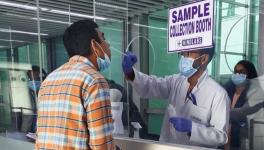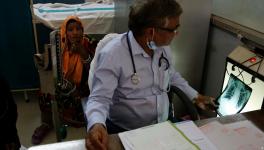How Aerosol Scientists Changed Our Understanding of Coronavirus—From Droplets to Airborne Transmission
At the beginning of the COVID-19 outbreak, the main way of transmission of the novel coronavirus—SARS-CoV-2—was thought to be via droplets carrying the virus. The understanding was that droplets come out of an infected person’s mouth and nose while speaking, coughing or sneezing. The main guidelines for prevention of Covid-19 were to maintain a distance of six feet, wash hands frequently or sanitizing and wearing masks.
The idea was that the large droplets can travel in the air up to just six feet and drop quickly on various surfaces. Within that range, inhaling such droplets could cause an infection. Or touching the surfaces on which the droplets fall upon and then touching one’s eye, nose and mouth can also cause the infection.
However, things have changed. Even though it has taken a year, health authorities have finally accepted that the virus is airborne and can travel much beyond the six-feet mark. It can also keep afloat in the air for a much longer time than large droplets. The CDC (Centre for Disease Control and Prevention), USA, came out with an update on May 7, 2021, which says that the virus can spread via fine aerosols as well and can transmit beyond six feet. It went on to say that the virus can transmit “in some cases to people who have passed through that space soon after the infectious person left”.
Similarly, WHO (World Health Organization) also has accepted that the coronavirus can spread through air. On April 30 this year, the WHO said that the coronavirus is readily spreading through air beyond the six feet distancing mark. The new acceptances are likely to have implications, such as overhauling ventilation systems, avoiding closed spaces, keeping doors and windows open etc.
The transformation in understanding of the virus’ transmission route has taken some time during the pandemic, but it has come so far thanks to the relentless efforts of few scientists in convincing the health authorities with their insightful arguments based on solid science.
Few days back, the Wired published a chronicle of how Linsey Marr, an aerosol scientist, working with other non-physicians struggled to convince the CDC and WHO that their perception had to be changed. The chronicle titled “The 60-year-old Scientific Screw-Up that Helped COVID Kill” began with Marr’s participation in a virtual conference back in April 2020 with other health experts, including those from the WHO and the CDC and other scientists around the world. The proposal that the virus must be airborne, by Marr and other aerosol scientists, was rejected in the conference with virtually no hearing.
There is a similar story to that of the SARS outbreaks in 2003. An indoor air researcher from the University of Hong Kong, Yuguo Li, provided strong evidence from his investigation that the coronavirus could be airborne. Li made a name for himself with his insights during the SARS outbreaks. However, he also had to fight to convince the health community about aerosol transmission and go beyond the 5-micron paradigm. In the earlier days of the Covid-19 pandemic, Li, with his prior knowledge of aerosol transmissio,n could convince the administrators of his university that most of the COVID-19 budget should be allocated for upgradation of ventilations in buildings and buses. In his university, which has over 30,000 students, only 23 got COVID-19.
Marr, after facing the rejection, not only kept on pushing the idea, but also dug deeper to find from where the dogma of 5-micron droplet size originated. Katie Randall, a graduate student, was assigned to search the history of the assumptions used by the WHO and the CDC. What came out of it is the underlying assumption in the Guidelines that particles of a size larger than 5 microns cannot be airborne.
That this assumption is outdated was proposed by Marr, well before the COVID19 outbreak took hold of the world. Her research paper, in 2011, was rejected by major medical journals except the Journal of Royal Society Interface. She performed new experiments and gathered stronger evidence that influenza was infecting people through aerosol, but it received only a lukewarm response in the medical research community.
What Katie Randall’s search revealed was how the 5 micron assumptions became a world-wide norm. She found that it was based on research on tuberculosis in 1930s and 40s. She was able to find a book authored by Harvard engineer William Firth Wells in 1955. More than half a century ago, Wells had proven that particles much larger than 5 microns can be airborne. He showed that a 100-micron particle can also become airborne, travel far through the air and remain afloat for quite some time. People can breathe such airborne particles and get infected. Ironically, Wells’ work could not find an acceptance even at that time by none other than the CDC .
In July last year, Marr along with some of her colleagues, initiated a campaign, where 237 other scientists and physicians signed. They wrote an open letter addressed to public health authorities, including the WHO, wherein they advocated for stronger recommendations for ventilations along with masking; otherwise, they stated, that the airborne transmission of the coronavirus would undermine every other effort like testing, tracing and social distancing.
This effort could catch the headlines. Soon after, the WHO came up with an updated brief where it acknowledged that aerosol cannot be ruled out, specifically in the areas that are poorly ventilated. However, WHO stuck to its 3 to 6 feet rule.
Marr continued to work to create awareness about the misunderstanding about aerosols. She tied up with Kimberly Prather, an atmospheric chemist at University of California, San Diego. They sent slides to Antonio Fauci, the director of NIAID ( National Institute of Allergy and infectious diseases). That was also in the month of July. One of the slides showed the trajectory of a 5-micron particle coming out from the mouth of a person of average height and it showed that the particle could travel beyond 6 feet. Fauci, after few weeks, said during an occasion at the Harvard Medical School that the 5-micron distinction was wrong. He said,“ Bottom line is, there is much more aerosol than we thought.”
However, the dogma did change. In October last year when Marr, along with a group of scientists and doctors, published a letter in thd Science where they urged everyone to understand how infectious particles travel. A month before the letter was published, CDC had updated its guidelines and said that the “main way” the novel coronavirus spreads is through droplets and aerosols. It was acknowledged in detail in a scientific brief published on May 7, 2021, on the CDC website. In case of the WHO, it was in December last year that the organisation began to talk about the possibility of airborne transmission of the virus. But it took another four months for it to finally say that the virus can spread via aerosols as well as via large droplets, which was published in its website on April 30.
Its late, but at last, the airborne transmission is accepted this time. The stories also show how outdated ideas can still overwhelm and influence decisions on public health guidelines. Hopefully, this will open up the way for other respiratory diseases, most common being the influenza, where evidences are mounting that they are airborne.
Get the latest reports & analysis with people's perspective on Protests, movements & deep analytical videos, discussions of the current affairs in your Telegram app. Subscribe to NewsClick's Telegram channel & get Real-Time updates on stories, as they get published on our website.
























